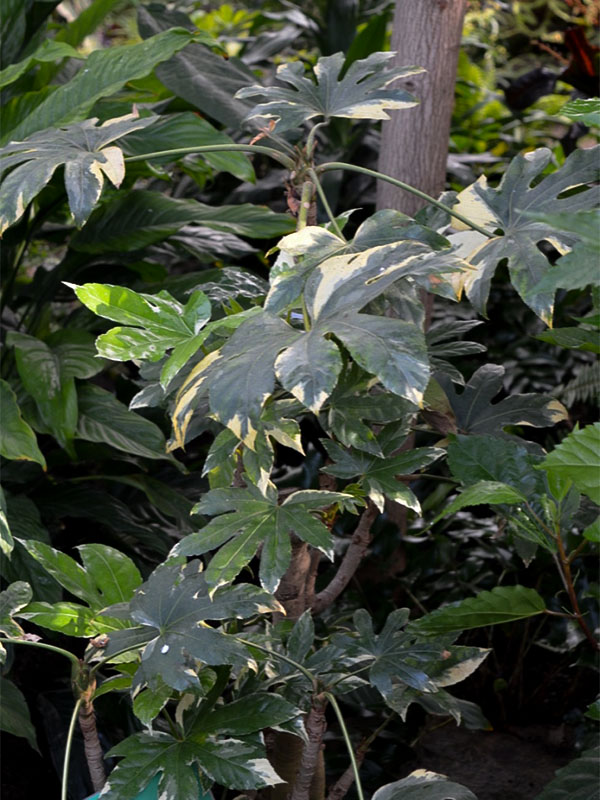
Woody > Fatsia > Fatsia japonica > Fatsia japonica
Fatsia japonica
Japanese aralia
Origin: Originated in southern Japan and was introduced to the western world in 1838.
Mike's
Opinion


"
Fatsia japonica is a bold, eye-catching plant that can tolerate a wide variety of soil conditions. Its large multi-lobed leaves, a tolerance to low light and the tropical texture make it a great addition to any garden or living space. - Emily Harvey
Michael Pascoe, NDP., ODH., CLT., MSc. (Plant Conservation)
"
| Family |
| Araliaceae |
| Genus |
| Fatsia |
| Species |
| japonica |
| Category |
| Woody |
| Type |
| Shrub (evergreen) |
| USDA Hardiness Zone |
| 8 - 10 |
| Canadian Hardiness Zone |
| 8a - 9b |
| RHS Hardiness Zone |
| H4 - H2 |
| Temperature (°C) |
| -12 - 4 |
| Temperature (°F) |
| 10 - 40 |
| Height |
| 2 – 3 m |
| Spread |
| 2 – 3 m |
Photographs
Description and Growing Information
Flowering Period
| General Description |
| A generally rounded open shaped plant with large, palmate, deeply lobed leaves. |
| Landscape |
| With a bold texture effect that is not easy to blend with other plants it would add an interesting and different specimen or hedge plant to any garden. It is ideal to use as an understory or shade planting. |
| Cultivation |
| For optimal growth it prefers moist, acidic soils ranging from 5-6.5 pH that are high in organic matter. They are tolerant of light sandy to heavy clay soils with less than optimal drainage. It is slightly cold tolerant but prefers a full shaded sheltered location that does not go below freezing and away from heavy winds. They prefer a humid location above 40% and are tolerant of air pollution and salt spray. |
| Shape |
| Commonly it has a rounded, open shape; but can also become full and densely shaped. |
| ID Characteristic |
| An evergreen that has a round open shape; with large, simple, deeply palmate leaves that have 7 - 9 deep lobes. Leaves are cordate that measure 15 - 35 cm across with serrated, acuminate shaped lobes with rounded sinuses. Leaves are a glabrous dark green on the top and a slightly paler on the underside with petioles that are 10 - 30 cm long, rounded, and smooth. Steams are green, coarse, thick and generally unbranched with large leaf scars marked on the stems. Older stems and trunk can develop a brown corking with age. |
| Pests |
| No pests pose major concerns, but mealy bugs, aphids, thrips, scale, and spider mites have been noted. |
| Habitat |
| It is native to the humid, coastal region of Japan. Typically growing in the under-canopy in moist soils with lots of organic matter. |
| Bark/Stem Description |
| Bark is soft wooded, smooth, thin, and green but can develop a brown corking on older stems and trunk. |
| Flower/Leaf Bud Description |
| Flower buds emerge in large, rounded clumps measuring 6 cm across. Each bud is wrapped in five sepals that are green to orange in colour. |
| Leaf Description |
| Large, simple, deeply palmate leaves that have 7 - 9 deep lobes. Leaves are cordate that measures 15 - 35 cm across that are divided just beyond the middle into oblong-ovate with serrated, acuminate shaped lobes with rounded sinuses. The top of the leaves are a glabrous dark green and slightly paler on the underside. They are alternately arranged with petioles that are 10 - 30 cm long, rounded, and smooth. |
| Flower Description |
| Flowers are white, petal-less, umbels that measure 2.5 - 4 cm in diameter that form a large terminal, umbellose panicle that measures up to 50 cm wide. Flower stalk is white and round and flowering period takes place between October to November. However, variable flowering periods have been noted depending on location. |
| Fruit Description |
| Inedible fruits are drupe, black, fleshy and 1 cm in diameter. They are arranged in a sub globose shape and ripen in mid to late winter and into the spring. |
| Colour Description |
| Top of the leaves are a glabrous dark green and a slightly paler on the underside. Stems are green that can develop a brown corking on older stems and the trunk. Flowers are white that later mature into black fruit. |
| Texture Description |
| Fatsia japonica has a coarse texture throughout all seasons. |
| Notable Specimens |
| Oregon State University in Corvallis, Oregon, United States of America has one located on their campus: north side Milam Hall. |
| Propagation |
| Seeds are best sown with clean fresh seeds and do not require a cold period. Place seeds in sterile well-draining media no deeper than 80 mm and place the remainder of the soil no more than 20 mm from the top of the pot. Level the media and thoroughly moisten the media. Store in a protected warm environment (greenhouse), the seeds germinate best in a dark environment. Once seedlings are large enough, transplant them into larger containers and place them in a shade house to harden off. Another method is softwood cuttings, which take cuttings from late autumn to early spring. Cut the stem below a node or joint, place the cutting in well-draining media, moisten thoroughly and place in a protected, warm, humid environment. Bottom heat is recommended but not necessary. |
References
Degman M. Plant profile No. 1: Fatsia japonica. Hardy Plant Society of Oregon Bulletin. 2004;20(1):78-79. Accessed March 29, 2022. https://search-ebscohost-com.ezpxy.fanshawec.ca/login.aspx?direct=true&db=edo&AN=13085074&site=eds-live
Dirr, M. A. (2009). Manual of woody landscape plants: Their identification, ornamental characteristics, culture, propagation and uses (6th ed.). Champaign, IL: Stipes.
